2014-2015学年度小学英语四年级英语集体备课unit4-4
- 格式:doc
- 大小:39.00 KB
- 文档页数:2

PEP人教版小学英语四年级英语下册Unit4集体备课电子教案单元计划表教学内容Unit4 课时划分4课时单元教学目标单元学习重点单元学习难点1、学生能灵活运用所学句型,能表演对话,注重合作精神,了解西方国家互相尊重,体谅对方的有关文明礼仪。
2、能简单描述农场里面的蔬菜和动物,能提问处于远或者近的物品是什么。
能掌握四会单词,和句型.并能够根据情境运用单词和句型交际。
结合上学期的知识拓展学生的交际语言。
能掌握简单的陈述句及一般疑问句和相应回答。
区分名词的单复数,在听说,读,练时能熟练运用。
能运用新句型描述自己的学校。
课时计划表(集体备课讨论)课题U4 At the farm 第(1)课时主备人谢晓岚教学目标1、听、说、认读主要语言结构:What are these?Are these...?并能根据实际情况进行简略回答。
2、能够准确朗读对话。
教学重点句型What are these?Are these…?及其简略回答。
教学难点these的发音。
教学准备课件,视频,学习单教学过程设计(幸福课堂模式)一.情景创设T:Today Sarah, Mike, Chenjie, John go tho Mr. Macdonald’s farm.What do they see? Let’t go and have a look, ok?1、教师和学生聊一聊每个人喜爱的蔬菜。
(I like…Do you like…?)2、教师说谜语,引导学生用Are they…?来猜猜是什么蔬菜。
a、They are red. They look like apples, but they aren’t apples. What are they?b、They are tender and green. What are they?c、They are long and orange. Rabbits like eating them. What are they?d、They are round, pink and white. What are they?e、They are brown. French fries are made of them. What are they?学生猜对了,教师回答Yes,they are.并拿出相应的单词卡片请学生拼读;如果猜错了,教师回答No, they aren’t.再请其他人猜, 直到猜对为止。
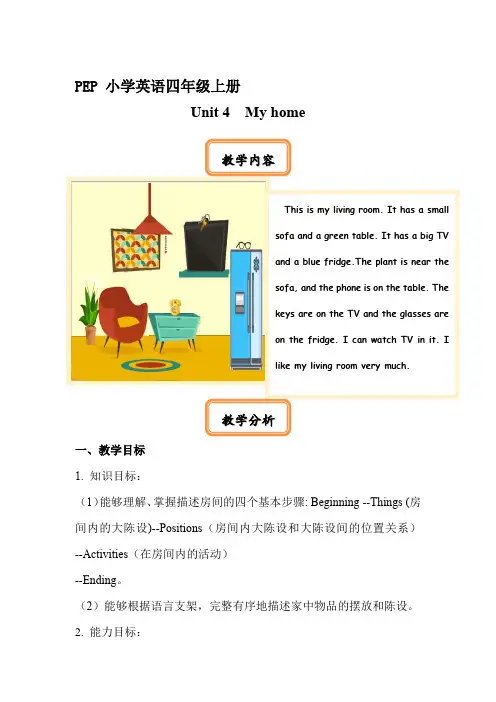
PEP 小学英语四年级上册Unit 4 My home教学内容This is my living room. It has a smallsofa and a green table. It has a big TVand a blue fridge.The plant is near thesofa, and the phone is on the table. Thekeys are on the TV and the glasses areon the fridge. I can watch TV in it. Ilike my living room very much.教学分析一、教学目标1.知识目标:(1)能够理解、掌握描述房间的四个基本步骤: Beginning --Things (房间内的大陈设)--Positions(房间内大陈设和大陈设间的位置关系)--Activities(在房间内的活动)--Ending。
(2)能够根据语言支架,完整有序地描述家中物品的摆放和陈设。
2. 能力目标:(1)能够对如何描述房间有了比较清晰、全面的认识。
(2)能够根据教师的引导,进行完整、有序地口语表达,并在表达时关注语言的逻辑顺序和句式结构。
3. 情感态度、学习策略目标:(1)通过本课的学习,培养和保持学生的英语学习兴趣。
(2)引导学生注重合作学习,培养合作、沟通、交流的意识和能力。
(3)培养学生爱自己的家、爱自己的家人的情感。
二、教学重难点分析1. 教学重点为根据描述房间的步骤,有序地、完整地描述房间中物品的摆放和陈设。
2. 难点为关于房间大陈设与小陈设之间位置关系的描述,即The...is/are..., and the...is/are...是本节课的难点。
三、课前准备CAI,Word cards教学过程What room is it? What’s in the rooms?扣,不仅复习了本单元的重点单词、句型,还激发了学生的学习兴趣,创建和谐快乐的课堂氛围。

人教版小学英语四年级上册Unit4What would you like?优秀教案及教学反思教材分析本单元围绕“食品、饮料和餐具”展开教学,教学内容与日常生活密切相关,不难激起学生们的学习兴趣,milk,bread,,water,egg等单词在三年级时听说读都已接触,老师重点让学生在“写”上下功夫,句型在回顾Can I have some ……,please ?的基础上,学习what would you like?句型,用来询问他人的需求,本单元八个四会单词,教师要严格要求,规范指导,为今后写的教学作个铺垫。
学情分析1、学生在学习单词比较薄弱,有些学生根本不愿意开口。
2、学生在学习食物的单词会比较感兴趣,但是在他们学会了这个单词时,他们不能用在生活中学习。
教学目标1、知识目标:认读本课中的单词和句子:rice,noodles,fish,beef,soup,vegetable,What would you like for dinner?I′d like some…2、能力目标:能够听、说、认读单词rice, noodles. fish.beef. soup. vegetable.初步掌握What would you like for dinner ? I’d like some ….3.情感、策略、文化等有关目标(1)情感态度:激发学生学习英语的兴趣,培养学生学习英语的积极态度,使学生乐于合作参与,勇于进行实践。
(2).学习策略:注重合作学习。
教学重点和难点教学重点:能听说,认读rice, noodles, fish, beef, soup, vegetable.教学难点:能够正确读单词vegetable.教学过程Step1 Preparation1.Enjoy the song “An apple a day”,师播放歌曲,让学生在快乐的学习氛围中投入到本节课学习。
2.Free talk.①T:(出示苹果图片)②T:(把图片给学生)③老师出示不同的图片,让学生问,学生答(生生互动,师生互动)可采用集体和个别结合的方式。

Unit4 At the farm A Let's learn 一、Teaching aims 1、Ss can master the following words: tomato、 green bean、 potato、 carrot 、onion and the plural nouns。 2、Ss can master the following sentences: Look at the .。. 。They are 。。. 。 二、Key points 1、Words: tomato、 potato、 onion、 carrot 、green bean. 2、Sentences:Look at the 。.。 。They are ..。 . 三、Difficult points Plural nouns(tomatoes、potatoes、onions、carrots、green beans。) 四、Teaching aids 1、 PPT。 2、 Word cards。(tomato、 potato、 onion、 carrot 、green bean. ) 3、 Records.(A Let's learn & Let’s chant) 4、 Flash.(A Let's learn & Let’s chant) 五、Teaching process 1、Greeting & warming up(2 minutes) T:Class begins. Ss:Stand up。 T:Good morning ,class。 Ss:Good morning ,Miss Qiu。 T:How are you today? Ss:I’m fine ,thank you.And you? T:Very well ,thanks.Are you ready for our English class? Ss:Yes。 T:Great。Sit down ,please。 Ss:Thank you。 2、Lead in(2 minutes) Enjoy a chant. T:Boys and girls,look at the pc screen.Let’s enjoy a chant. I like tomatoes. I like potatoes。 Carrots I will try. I love to eat green beans。 But onions make me cry。 3、presentation(16 minutes) (1)Tomato T:Wow!There are so many vegetables in this chant。The first one is tomato。 Read after me。 Tomato, to-ma—to tomato,tomato↗↘,tomato↗↘,tomato↗↘。 Ss:Tomato,to-ma-to tomato,tomato↗↘,tomato↗↘,tomato↗↘。 T:Group by group。Are you ready? Ss:Yes. T:Group1、2、.。.5,tomato. Group1、2、。.。5:tomato。 T:Good,nice,great,wonderful,excellent.Together. Ss:Tomato. T:Wow,wow,wonderful。 Ss:Wow,wow,wonderful。 T:(Take out a tomato。)Look,What's this? Ss:It's a tomato。 T:(Take out 2 tomatoes.)Look,What’s these? Ss:They are tomatoes。 T:You are so clever。 Read after me。Look at the tomatoes。 Ss:Look at the tomatoes。 T:What color are they? Ss:Red。 T:Look at the tomatoes。They are red。 Ss:Look at the tomatoes。They are red。 T:Who can try?You please. S1:Look at the tomatoes.They are red. T:Good。You please。 S2:T:Look at the tomatoes。They are red。 T:Wonderful。 .。。 T:Together. Ss:Look at the tomatoes.They are red. T:Wow,wow,wonderful。 Ss:Wow,wow,wonderful。 (2)Potato T:The second one is potato. Read after me. Potato, po—ta-to potato,potato↗↘,potato↗↘,potato↗↘. Ss:Potato, po—ta-to potato,potato↗↘,potato↗↘,potato↗↘. T:Group by group.Are you ready? Ss:Yes。 T:Group1、2、。。。5,potato。 Group1、2、...5:potato。 T:Good,nice,great,wonderful,excellent。Together. Ss:Potato。 T:Wow,wow,wonderful。 Ss:Wow,wow,wonderful. T:(Take out a potato。)Look,What’s this? Ss:It's a potato。 T:(Take out 2 potatoes。)Look,What's these? Ss:They are potatoes. T:You are so clever. Read after me.Look at the potatoes. Ss:Look at the potatoes. T:What color are they? Ss:Brown。 T:Look at the potatoes。They are brown. Ss:Look at the potatoes.They are brown. T:Who can try?You please. S1:Look at the potatoes。They are brown. T:Good。You please. S2:Look at the potatoes。They are brown。 T:Wonderful。 .。. T:Together. Ss:Look at the potatoes.They are brown。 T:Wow,wow,wonderful. Ss:Wow,wow,wonderful。 (3)Carrot T:The third one is carrot。 Read after me。 Carrot, ca-rrot,carrot,carrot↗↘,carrot↗↘,carrot↗↘。 Ss:Carrot, ca-rrot,carrot,carrot↗↘,carrot↗↘,carrot↗↘。 T:Group by group。Are you ready? Ss:Yes。 T:Group1、2、.。.5,carrot。 Group1、2、。。.5:carrot. T:Good,nice,great,wonderful,excellent。Together。 Ss:Carrot. T:Wow,wow,wonderful. Ss:Wow,wow,wonderful. T:(Take out a carrot.)Look,What’s this? Ss:It's a carrot. T:(Take out 2 carrots.)Look,What's these? Ss:They are carrots。 T:You are so clever. Read after me。Look at the carrots。 Ss:Look at the carrots。 T:What color are they? Ss:Orange. T:Look at the carrots。They are orange。 Ss:Look at the carrots.They are orange. T:Who can try?You please。 S1:Look at the carrots。They are orange. T:Good。You please。 S2:Look at the carrots.They are orange。 T:Wonderful. .。. T:Together。 Ss:Look at the carrots.They are orange. T:Wow,wow,wonderful. Ss:Wow,wow,wonderful. (4)Green bean T:The fourth one is green bean. Read after me. Green bean, green bean,green bean↗↘,green bean↗↘,green bean↗↘. Ss:Green bean, green bean,green bean↗↘,green bean↗↘,green bean↗↘. T:Group by group.Are you ready? Ss:Yes。 T:Group1、2、.。。5,green bean. Group1、2、.。.5:green bean. T:Good,nice,great,wonderful,excellent。Together. Ss:Green bean.
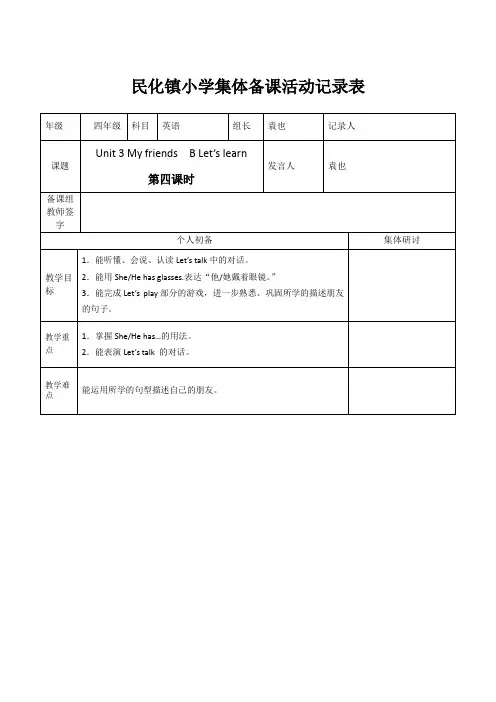
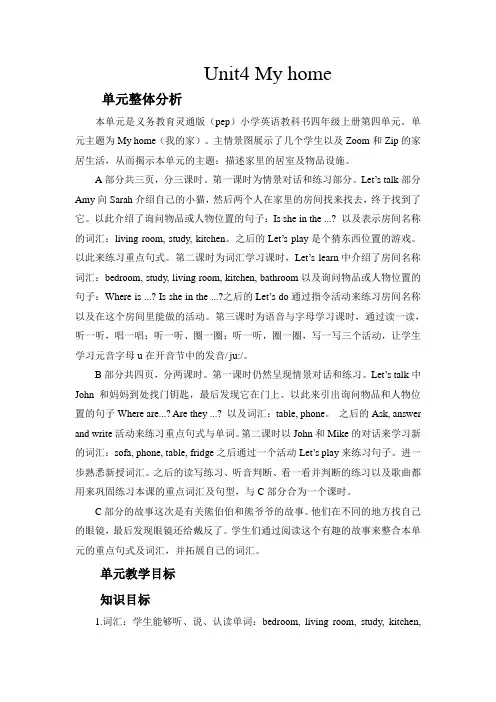
Unit4 My home单元整体分析本单元是义务教育灵通版(pep)小学英语教科书四年级上册第四单元。
单元主题为My home(我的家)。
主情景图展示了几个学生以及Zoom和Zip的家居生活,从而揭示本单元的主题:描述家里的居室及物品设施。
A部分共三页,分三课时。
第一课时为情景对话和练习部分。
Let’s talk部分Amy向Sarah介绍自己的小猫,然后两个人在家里的房间找来找去,终于找到了它。
以此介绍了询问物品或人物位置的句子:Is she in the ...? 以及表示房间名称的词汇:living room, study, kitchen。
之后的Let’s play是个猜东西位置的游戏。
以此来练习重点句式。
第二课时为词汇学习课时,Let’s learn中介绍了房间名称词汇:bedroom, study, living room, kitchen, bathroom以及询问物品或人物位置的句子:Where is ...? Is she in the ...?之后的Let’s do通过指令活动来练习房间名称以及在这个房间里能做的活动。
第三课时为语音与字母学习课时,通过读一读,听一听,唱一唱;听一听、圈一圈;听一听,圈一圈,写一写三个活动,让学生学习元音字母u在开音节中的发音/ju:/。
B部分共四页,分两课时。
第一课时仍然呈现情景对话和练习。
Let’s talk中John和妈妈到处找门钥匙,最后发现它在门上。
以此来引出询问物品和人物位置的句子Where are...? Are they ...? 以及词汇:table, phone。
之后的Ask, answer and write活动来练习重点句式与单词。
第二课时以John和Mike的对话来学习新的词汇:sofa, phone, table, fridge之后通过一个活动Let’s play来练习句子。
进一步熟悉新授词汇。
之后的读写练习、听音判断、看一看并判断的练习以及歌曲都用来巩固练习本课的重点词汇及句型,与C部分合为一个课时。
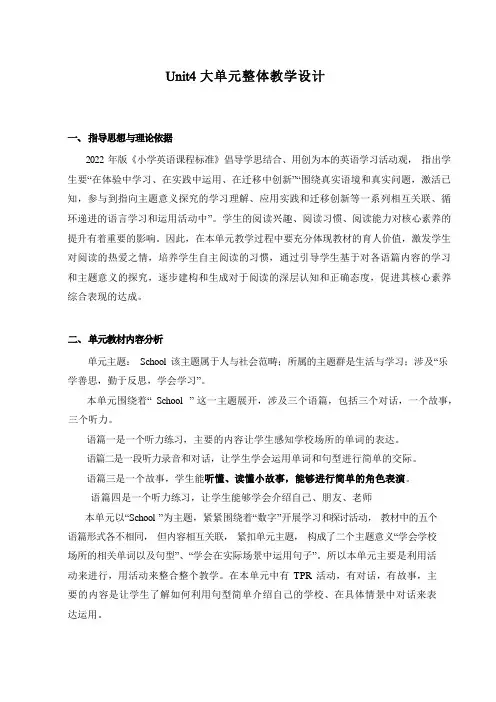
2022 年版《小学英语课程标准》倡导学思结合、用创为本的英语学习活动观,指出学生要“在体验中学习、在实践中运用、在迁移中创新”“围绕真实语境和真实问题,激活已知,参与到指向主题意义探究的学习理解、应用实践和迁移创新等一系列相互关联、循环递进的语言学习和运用活动中”。
学生的阅读兴趣、阅读习惯、阅读能力对核心素养的提升有着重要的影响。
因此,在本单元教学过程中要充分体现教材的育人价值,激发学生对阅读的热爱之情,培养学生自主阅读的习惯,通过引导学生基于对各语篇内容的学习和主题意义的探究,逐步建构和生成对于阅读的深层认知和正确态度,促进其核心素养综合表现的达成。
单元主题: School 该主题属于人与社会范畴;所属的主题群是生活与学习;涉及“乐学善思,勤于反思,学会学习”。
本单元围绕着“ School ” 这一主题展开,涉及三个语篇,包括三个对话,一个故事,三个听力。
语篇一是一个听力练习,主要的内容让学生感知学校场所的单词的表达。
语篇二是一段听力录音和对话,让学生学会运用单词和句型进行简单的交际。
语篇三是一个故事,学生能听懂、读懂小故事,能够进行简单的角色表演。
语篇四是一个听力练习,让学生能够学会介绍自己、朋友、老师本单元以“School ”为主题,紧紧围绕着“数字”开展学习和探讨活动,教材中的五个语篇形式各不相同,但内容相互关联,紧扣单元主题,构成了二个主题意义“学会学校场所的相关单词以及句型”、“学会在实际场景中运用句子”。
所以本单元主要是利用活动来进行,用活动来整合整个教学。
在本单元中有TPR 活动,有对话,有故事,主要的内容是让学生了解如何利用句型简单介绍自己的学校、在具体情景中对话来表达运用。
1.初步感知学校场所的单词和句型Part1 对话、听力(1 课时)2.初步感知介绍自己学校的简单句型表达Part2 听力、对话(1 课时)3.读懂故事,并进行角色扮演Part3故事(1 课时)4.通过学习能在老师的指导下利用句型进行简单的交际Part4听力、对话练习(1 课时)初步感知学校场所的单词和句型Lesson1听力、对话能正确读出,规范书写单词----gym, library,playground, canteen,computer room,classroom, grasp themeaning of the words.能在老师指导下运用Are there…?/Isyour…big(small)?等句型进行简单交际。
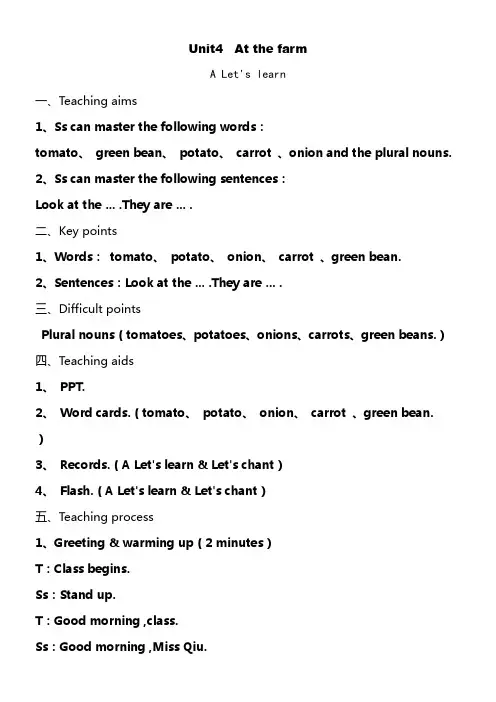
Unit4 At the farmA Let's learn一、Teaching aims1、Ss can master the following words:tomato、green bean、potato、carrot 、onion and the plural nouns.2、Ss can master the following sentences:Look at the ... .They are ... .二、Key points1、Words:tomato、potato、onion、carrot 、green bean.2、Sentences:Look at the ... .They are ... .三、Difficult pointsPlural nouns(tomatoes、potatoes、onions、carrots、green beans.)四、Teaching aids1、PPT.2、Word cards.(tomato、potato、onion、carrot 、green bean.)3、Records.(A Let's learn & Let's chant)4、Flash.(A Let's learn & Let's chant)五、Teaching process1、Greeting & warming up(2 minutes)T:Class begins.Ss:Stand up.T:Good morning ,class.Ss:Good morning ,Miss Qiu.T:How are you today?Ss:I'm fine ,thank you.And you?T:Very well ,thanks.Are you ready for our English class?Ss:Yes.T:Great.Sit down ,please.Ss:Thank you.2、Lead in(2 minutes)Enjoy a chant.T:Boys and girls,look at the pc screen.Let's enjoy a chant.I like tomatoes.I like potatoes.Carrots I will try.I love to eat green beans.But onions make me cry.3、presentation(16 minutes)(1)TomatoT:Wow!There are so many vegetables in this chant.The first one is tomato.Read after me. Tomato, to-ma-to tomato,tomato↗↘,tomato↗↘,tomato↗↘.Ss:Tomato,to-ma-to tomato,tomato↗↘,tomato↗↘,tomato↗↘.T:Group by group.Are you ready?Ss:Yes.T:Group1、2、...5,tomato.Group1、2、...5:tomato.T:Good,nice,great,wonderful,excellent.Together. Ss:Tomato.T:Wow,wow,wonderful.Ss:Wow,wow,wonderful.T:(Take out a tomato.)Look,What's this?Ss:It's a tomato.T:(Take out 2 tomatoes.)Look,What's these?Ss:They are tomatoes.T:You are so clever.Read after me.Look at the tomatoes.Ss:Look at the tomatoes.T:What color are they?Ss:Red.T:Look at the tomatoes.They are red.Ss:Look at the tomatoes.They are red.T:Who can try?You please.S1:Look at the tomatoes.They are red.T:Good.You please.S2:T:Look at the tomatoes.They are red.T:Wonderful....T:Together.Ss:Look at the tomatoes.They are red.T:Wow,wow,wonderful.Ss:Wow,wow,wonderful.(2)PotatoT:The second one is potato.Read after me. Potato, po-ta-to potato,potato↗↘,potato↗↘,potato↗↘.Ss:Potato, po-ta-to potato,potato↗↘,potato↗↘,potato↗↘.T:Group by group.Are you ready?Ss:Yes.T:Group1、2、...5,potato.Group1、2、...5:potato.T:Good,nice,great,wonderful,excellent.Together.Ss:Potato.T:Wow,wow,wonderful.Ss:Wow,wow,wonderful.T:(Take out a potato.)Look,What's this?Ss:It's a potato.T:(Take out 2 potatoes.)Look,What's these?Ss:They are potatoes.T:You are so clever.Read after me.Look at the potatoes.Ss:Look at the potatoes.T:What color are they?Ss:Brown.T:Look at the potatoes.They are brown.Ss:Look at the potatoes.They are brown.T:Who can try?You please.S1:Look at the potatoes.They are brown.T:Good.You please.S2:Look at the potatoes.They are brown.T:Wonderful....T:Together.Ss:Look at the potatoes.They are brown.T:Wow,wow,wonderful.Ss:Wow,wow,wonderful.(3)CarrotT:The third one is carrot.Read after me. Carrot, ca-rrot,carrot,carrot↗↘,carrot↗↘,carrot↗↘. Ss:Carrot, ca-rrot,carrot,carrot↗↘,carrot↗↘,carrot↗↘.T:Group by group.Are you ready?Ss:Yes.T:Group1、2、...5,carrot.Group1、2、...5:carrot.T:Good,nice,great,wonderful,excellent.Together.Ss:Carrot.T:Wow,wow,wonderful.Ss:Wow,wow,wonderful.T:(Take out a carrot.)Look,What's this?Ss:It's a carrot.T:(Take out 2 carrots.)Look,What's these?Ss:They are carrots.T:You are so clever.Read after me.Look at the carrots.Ss:Look at the carrots.T:What color are they?Ss:Orange.T:Look at the carrots.They are orange.Ss:Look at the carrots.They are orange.T:Who can try?You please.S1:Look at the carrots.They are orange.T:Good.You please.S2:Look at the carrots.They are orange.T:Wonderful....T:Together.Ss:Look at the carrots.They are orange.T:Wow,wow,wonderful.Ss:Wow,wow,wonderful.(4)Green beanT:The fourth one is green bean.Read after me. Green bean, green bean,green bean↗↘,greenbean↗↘,green bean↗↘.Ss:Green bean, green bean,green bean↗↘,green bean↗↘,green bean↗↘.T:Group by group.Are you ready?Ss:Yes.T:Group1、2、...5,green bean.Group1、2、...5:green bean.T:Good,nice,great,wonderful,excellent.Together.Ss:Green bean.T:Wow,wow,wonderful.Ss:Wow,wow,wonderful.T:(Take out a green bean.)Look,What's this?Ss:It's a green bean.T:(Take out 2 green beans.)Look,What's these?Ss:They are green beans.T:You are so clever.Read after me.Look at the green beans.Ss:Look at the green beans.T:What color are they?Ss:Green.T:Look at the green beans.They are green.Ss:Look at the green beans.They are green.T:Who can try?You please.S1:Look at the green beans.They are green.T:Good.You please.S2:Look at the green beans.They are green.T:Wonderful....T:Together.Ss:Look at the green beans.They are green.T:Wow,wow,wonderful.Ss:Wow,wow,wonderful.(5)OnionT:The last one is onion.Read after me. Onion, o-nion,onion,onion↗↘,onion↗↘,onion↗↘. Ss:Onion, o-nion,onion,onion↗↘,onion↗↘,onion↗↘.T:Group by group.Are you ready?Ss:Yes.T:Group1、2、...5,onion.Group1、2、...5:onion.T:Good,nice,great,wonderful,excellent.Together.Ss:Onion.T:Wow,wow,wonderful.Ss:Wow,wow,wonderful.T:(Take out a onion.)Look,What's this?Ss:It's a onion.T:(Take out 2 onions.)Look,What's these?Ss:They are onions.T:You are so clever.Read after me.Look at the onions.Ss:Look at the onions.T:What color are they?Ss:Purple.T:Look at the onions.They are purple.Ss:Look at the onions.They are purple.T:Who can try?You please.S1:Look at the onions.They are purple.T:Good.You please.S2:Look at the onions.They are purple.T:Wonderful....T:Together.Ss:Look at the onions.They are purple.T:Wow,wow,wonderful.Ss:Wow,wow,wonderful.4、ConsolidationT:Boys and girls,look at the pc screen,Let's read the chant together. Ss:Look at the tomatoes.They are red.Look at the potatoes.They are brown.Look at the carrots.They are orange.Look at the green beans.They are green.Look at the onions.They are purple.T:Wow,wow,wonderful.Ss:Wow,wow,wonderful.T:Boys and girls,look at the pc screen.Listen and look A Let's learn. T:Now,read after the tape.Ss:...T:Boys and girls,open your English book and turn to page 39.Now read after me. ...Ss:...T:OK.You read the words and sentences together.Ss:...T:Wow,wow,wonderful.Ss:Wow,wow,wonderful.T:Boys and girls,look at the pc screen.There are 5 vegetables.I'd like divide you into groups.Each group has 4 e the sentences and describe 2 of the vegetables.I'll give you 2minutes.Let's go.T:Boys and girls,time's up.Are you ready?Ss:Yes.T:You please.G1:...T:Good.You please.G2:...T:Wonderful.You please....六、Homewore1、Copy the new words and sentences 4 times.2、Listen and read A Let's talk and Let's chant.七、Blackboard designUnit 4 At the farmA Let's learnLook at the tomatoes.They are red.Look at the potatoes.They are brown.Look at the carrots.They are orange.Look at the green beans.They are green.Look at the onions.They are purple.八、Teaching reflectionI think I should pay more attention to the plural nouns.。

Unit4 my homeB Let’s Learn教案设计一、教学目标1、知识技能:能听、说、认读本课主要单词phone /fridge/sofa/ bed/ table等单词。
会在日常生活中运用所学单词能听懂本课Let's do中的指示语,并能按指令相应动作。
2、过程方法:通过Warm-up对A部分的Let's do进行复习巩固,为进一步学习单词奠定基础。
把单词置于生活情境中去,使学生的学习不会感到枯燥乏味。
以旧联新,形成网络式知识教学。
形象直观化的教学,学生乐于接受,有助于帮助学生有效记忆单词。
3、情感、态度和价值观:通过课堂上一系列的游戏与活动,激发学生的学习兴趣,树立他们学习英语的自信心。
最后通过让学生与其他同学分享自己的房间的设计思路,培养学生对家的热爱,鼓励学生大胆设计自己未来的家居。
通过Group work培养学生与他人合作的学习能力。
二、教学内容:本课是PEP四年级上册Unit 4 Part B Let’s Learn部分的内容,主要学习phone shelf fridge sofa bed table等单词。
三、学情分析:本课时主要是在上节课学习家里的各类房间study,bedroom,living room,bathroom,kitchen等名称之后,围绕各类房间里一些常见的家具phone、fridge、TV、sofa、table、shelf 、bed等展开的一系列话题,这些东西都是学生非常熟悉而且和我们息息相关的,学生有了一定的语言基础和英语学习能力。
所以教师教起来比较顺手,学生也乐于学习,并易于在生活中进行运用。
大部分学生学习兴趣浓厚,能够主动与同伴交流,较好的完成教学任务;但是还有少数学生积极性不高,所以教师要通过创设情境和设计游戏等孩子们喜闻乐见的方式,提高孩子们学习英语的兴趣,这样孩子们才愿意学,爱上英语课。
四、教学重难点能听、说、认读单词phone,bed,sofa,shelf,fridge,table.发音:phone不要丢掉尾音; bed 、shelf两个单词注意[e]的发音。

Pep小学英语四年级下册Unit4 At the farm教学设计单元教学目标:总目标:能够在“At the farm”这个情景中运用句型What are these/those? They are---.及They are so big/---.询问并回答各种蔬菜或动物的名称及物品特点,并把他们运用到生活实际中。
分目标:知识与能力目标:句型:1、能够听、说、认、读句型:Are these carrots? Yes, they are./No, they aren’t.What are these/those? They’re tomatoes/sheep. How many horses do you have? Seventeen.2、能够在情景中运用句型:What are these/those? They’re ---.询问并回答各种蔬菜或动物的名称。
3、能够在情景中运用句型:They are so big/---.描述物品特点。
4、能够按意群朗读介绍农场上蔬菜和动物的短文;能够在有意义的语境中模仿写句子These/Those are---.词汇:1、能够听、说、认、读单词:tomato, green bean, potato, carrot, cow, hen, sheep ,horse及其复数形式。
2、能够正确使用上述单词和these/those介绍各种农场动物及蔬菜。
语音:1、能够掌握字母组合or的发音规则。
2、能够读出符合or发音规则的单词;能够根据读音拼写符合or发音规则的单词。
3、能够填充短语或句子,做到书写规范。
情感态度和文化意识:了解几条与动物有关的英语习语Pep小学英语四年级下册unit4 At the farmB Let’s talk松山五小姜瑞华教学目标:1、学生能够理解对话大意。
2、能够用正确的语音、语调朗读对话。
3、能够在情景中恰当的运用句型What are those? They are ---.问答物品名称。
姚村镇2014-2015学年度第一学期小学集体备课及二次备课
4 年级英语学科主备人:杨芝使用人:
课题Unit 4 My home 第4 课时
备课组成员孟凡荣张波闫婷婷宋文云陈贵芝
教学目标1.能听懂、会说:Where are…?Are they…?Yes,they are./No,they aren’t并能在实际情境中运用。
2.通过Let’s chant,使学生复习巩固Let’s talk中学过的语言。
3.了解Story time的故事内容。
重点难点听说认读句型Where are …? Are they…? Yes, they are. /No ,they aren’t并在实际中运用。
教学准备.教材相配套的教学课件;教材相配套的教学录音带,教学光盘。
教学方法小组合作学习,自主探究
教学过程Step 1 Warm-up
Guessing game: 教师让全体学生闭上眼睛,将pen藏在一个学生的课
桌里。
说:Where is it? 假装问:Is it in your pencil-box? 学生回答:No,
it isn’t. 直到找到,学生回答:Yes, it is.教师将pencil藏起来,让学生
用Is it…?来提问,被问到的学生回答:No, it isn’t./ Yes, it is.(为寻找
范围过大,教师可以划定范围。
第一组或第一排。
)
Step 2 Presentation
A.情境导入
教师拿出一个书包,说There are many books in this schoolbag. What are
they? Are they notebooks? 引导学生用Are they…? 来猜一猜, 让学生用
Yes,they are.No,they aren’t.猜出正确答案:They are story books.
B.机械训练
1.教师指着板书领读问答句(肯定、否定回答)。
2.学生两人一组练读问答句(用手中的学习用品)。
3.检查一两组学生。
C.意义操练
教师出示Let’s chant的课件。
告诉学生这是Sarah的一家人。
让学生
就此提问,Where is Sarah’s mother/father/brother/sister? Mother is in the
living room….
Step3 Practice
A.听音答题
二次备课
教学过程先让学生边听录音,边思考:Where are the keys?
B.听音正音
1.听录音,跟读课文对话。
2.让学生自己尝试读对话。
C.合作共建x k b 1. c o m
两人一组分角色读对话。
(交代学生,不要忘了轮流换角色。
)
D.表演展示
让学生做对话表演,评出一组“最佳搭档”。
Step 4 tProduction
游戏:帮妈妈找钥匙
Step 5 Homework
听录音,仿读对话;
二次备课
板
书设计
Unit4 My home Where are…?Are they…?
Yes, they are./No, they are’t.
教学反思。